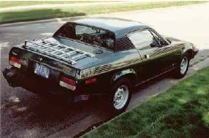


Unravelling the production history of the TR7 and TR8 is a challenging endeavour. Three factories built the cars during their production run from 1975-81: Speke, Canley and Solihull. During some periods, two factories assembled the cars so production overlapped. At other times the lines were shut down, but some cars were apparently built even then! Launch dates for various models were announced, revised, and postponed, sometimes for years. Vehicle identification numbers were not consecutive, appear randomly assigned, and sometimes defy interpretation. Many TR8s actually have two vehicle identification numbers (a North American number, and a factory number), and inconsistent codes for equipment, trim, and body paint confuse things even more. So be warned!
It is generally agreed that cars built at Speke suffer from more problems than cars from the other two locations, with cars from Solihull most desirable largely because they are the newest. Labour strife plagued the entire British automobile industry in the mid-70s, with strikes and sabotage common. The Speke factory was in the thick of this and even though it was only 20 years old, the company's final solution was to permanently close the Speke operation in 1978. Production of the TR7 then moved to Canley. If you have a TR7 with original paint, you can immediately tell if it is a Speke car by the big TR7 decal on the nose. The decal on the Canley cars changed to a large wreath with the word Triumph in the center. A black badge with gold wreath and Triumph lettering identifies the Solihull cars.
While styling differences between NA and rest-of-the-world specification cars are not large, there are significant differences in TR7 engine specification. From the beginning, Triumph supplied engines in three states of tune. Outside NA, the engine used twin SU carburetors to develop 105hp, but in 49-State tune the car ran twin Zenith-Strombergs and made 90hp. In Californian tune the car was only able to generate 76hp due to emissions equipment and a single carburetor. The California cars subsequently received twin Stombergs from 77-79, and fuel injection from 1980. All 1981 US cars were fuel injected using a Bosch L-Jetronic system (with the TR8 getting a specially designed Lucas ECU), although Canadian TR7s continued to use twin Strombergs.
Early cars came with 4-speed transmissions and 175/70-13 tires for all markets, but by 1977 Triumph offered a superior 5-speed transmission. A higher final drive ratio of 3.9:1 came with the 5-speed 'box, as did high performance 185/70HR-13 tires. Triumph standardized this specification for the NA market, but due to supply problems it was only briefly offered, then dropped, for the home market. The option was not reliably offered again outside NA until production moved to Canley in 1978, for the 1979 model year. Triumph also introduced an automatic transmission from 1976, maybe earlier, but it was never very popular.
The 1977 model year also saw the general introduction of catalytic converters (Californian cars had them from 1975) and the elimination of the small British Leyland badges at the bottom of the fenders, behind the front wheels. By March 1977 the wheel center rings changed from black to silver, and a fabric sunroof became an option. Still fiddling with the look of the car, Triumph engineers lowered its rear by 1 inch, and changed the interior from a spun nylon corduroy to a very distinctive red or green plaid. This was not an understated plaid, and if the idea was to draw peoples' attention away from the car's controversial shape, then full marks should certainly be given. When selecting an adjective to describe this particular plaid, the word loud comes fairly quickly to mind. These days, fans of the early TR7s regard this interior with great affection, as do owners of the Speke-built pre-production TR8 coupes, and early production coupes that also received it.
In October 1977, workers at the Speke factory went on strike. This, of course, coincided with the introduction of the 1978 model TR7, with the result that very few 1978 TR7s exist. Even though the factory resumed production in March 1978, its operation was short-lived: It closed in May for good. Production of the TR7 moved to Canley (Coventry) and resumed in October 1978, which meant that Triumph missed almost an entire model year. None of this inspired buyer confidence.
While the Canley TR7s didn't look significantly different than those from Speke, they did receive a number of improvements. A nicer steering wheel was fitted, and the hood (bonnet) acquired a small power bulge. Alloy wheels and a front spoiler became a dealer option. The five-speed gearbox was finally standardized across the range, coupes got a sunroof, and many changes improved the operation of the car, including upgraded instrumentation, cooling and electrics. Advertising of the day emphasized these changes: "A team of 67 inspectors constantly monitors the Canley assembly line. Then a second group of inspectors monitor the 67 inspectors." "But that's not all," the copy continues, "each TR7 is given a further 58 point post-assembly check, then another multi-point inspection." Get the point? There was a whole lotta checkin' goin' on at Canley, not to mention that "craftsmen and engineers with 50 years of inherited sportscar expertise" were now building TR7s. No mention was made of Speke.
The big deal for 1979, though, was the introduction of the TR7 convertible, finally. These cars hit NA showrooms in late summer, 1979, but the rest of the world had to wait until 1980. Triumph invites you to a new opening, was the heading on the two-page colour ad in the August 1979 issue of Road & Track. And there was a white TR7 drophead, black roof, shiny black bumpers, sharp red and black plaid interior. Very nice.
It was at Canley as well that production of the TR8 finally began. Triumph introduced the convertible car to the US press in March, 1980, and offered it for sale the following May. However, this was not the first time the press had been invited to drive the TR8. A Road & Track article of June, 1979 documents the driving impressions of automotive journalists in what must have been winter 1978 (snow is on the ground in the accompanying pictures) in Donington, England. This would suggest that production of TR8 coupes actually began in late 1978, shortly after the TR lines began at Canley. The point is important to make, as several writers suggest there were no TR8 production coupes built. On the contrary, Road & Track, in June, 1980, reports that 10% of (approximately 250) TR8s were expected to be coupes, and, as mentioned earlier, 47 of these cars have their TCN-style VINs currently listed with the TR8 Car Club of America, the earliest one having been built in November, 1978. There is also a factory sales brochure for the TR8 coupe, and this, interestingly, was printed in September 1977, a month before the Speke strike.
It was the convertibles, though, that got all the attention for here was a car that was universally praised. All the magazine reviews were positive. Car and Driver featured the car on the cover of its August 1980 issue -- stunning metallic Triton green with tan tartan interior -- and enthusiastically described it as Nothing less than the reinvention of the sports car. Phew! Unfortunately, Triumph built only 2715 of these wonderful cars.
Canley TR8s have the newly designed TR8 logo in large letters on the nose of the car, and 3.5 litre decals located low on the fenders where the British Leyland crest used to be. Compared to the TR7, the car was lowered 1 inch front and back, featured a revised suspension, power steering, 13 inch Moto-Lita steering wheel, full dual exhaust and, of course, the engine.
As is now well known, the aluminum block Rover V8 derives from the General Motors 215 c.i. aluminum V8 as used in Buicks and Oldsmobiles of the early 60s. When used in the TR8 it was initially available with fuel injection for the California market, and with twin Strombergs for the rest of NA. All TR8s received fuel injection when production moved to Solihull in late 1980.
The Solihull facilities were the last stop for TR7s and 8s, and, in fact, it was the production site for only about 8,000 cars, or 7% of the total run. There the cars ultimately lost their tasteful tan or navy tartan interiors in favour of a still pleasant, plain nylon interior (early NA cars used the tartan style, and rest of the world cars stayed with tartan). They also acquired a gray-blue dashboard, as opposed to the earlier black version. Metallic paints were a widely selected option and, as mentioned earlier, all Solihull cars used the plastic Triumph badge for the nose of the car. The very last cars have other small detail improvements, such as a quartz clock, and adjustment of the clock and trip odometer accessible through the instrument cluster, rather than under the dash (although these features seem to have been applied in a somewhat haphazard fashion). Some, too, have a navy or tan convertible top, rather than the usual black one.
All 1981 TR7s and 8s were built at Solihull, although there were also some 1980 models built there, including the special edition Spider. With one exception, no advertising or primary documentation is as yet available to support the position that 1982 models were produced. Nonetheless, according to at least two enthusiasts, some of the very late cars destined for Canada apparently had their vehicle identification numbers selected by the factory to designate them 1982 models. This is supported by a memo on JRT stationary and reproduced in Issue 2 of the TR8 Car Club of America newsletter. Graham W. Gardner wrote the memo, dated 26/10/82. It clearly refers to 75 1982 TR8s shipped to Canada, but other factory documentation does not mention these cars. In addition, there were apparently a handful (36?) UK specification TR8s built for release to automotive journalists for testing and publicity. This would have probably been in August or September of 1981. The production of these cars, the first TR8s made for the home market, would surely have been something of an event but these cars were auctioned off after the lines shut down.
One wonders what it must have been like on the line and in the offices at Solihull on October 5th, 1981, ironically a Monday, the beginning of a work-week. Were people excited about the new home market TR8 model? Had advertising concepts been discussed and plans developed? Were the lines gearing up for anticipated volume runs? Or was morale low, with people going through the motions, expecting the axe to fall at any time? Perhaps generally it was not an issue, as the new Honda-based Triumph Acclaim was about to go on sale two days after the last TR, a TR7, came off the line. The October 5th entry in the Solihull factory despatch book concerning TR production is a large THE END, written between two red lines. Underneath, some hopeful soul has written, "Or is it?"
It turns out that BMW is now the owner of the Triumph name (along with Austin-Healey, Riley and, of course, MINI). There's no talk at all of a Triumph revival, or mention of a TR9, but it has a nice ring to it...
Production History

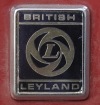

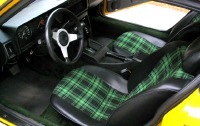
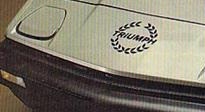
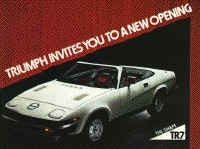
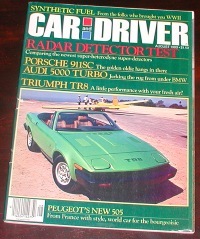

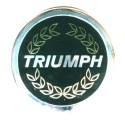

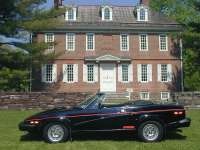
On to Special Editions

